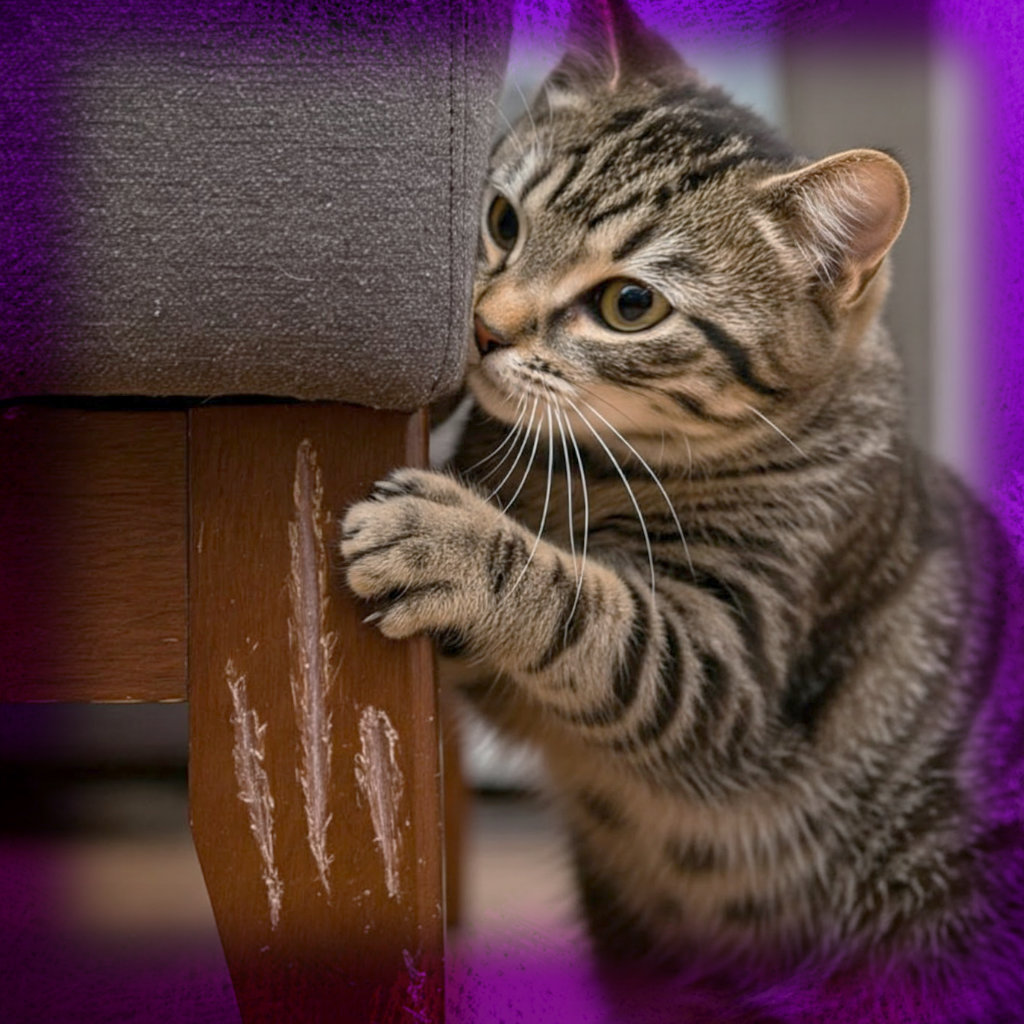The Frustration of Ruined Furniture
Few things are as disheartening as discovering fresh claw marks on your favorite couch or antique wooden chair. For cat owners, this is an all-too-familiar battle. While feline companions bring joy, their scratching habits can wreak havoc on home decor. Understanding why cats scratch—and how to redirect this behavior—is the first step toward preserving both your furniture and your sanity.
Why Do Cats Scratch?
Scratching is an innate feline behavior, not an act of spite. Cats scratch to stretch their muscles, shed old claw sheaths, and mark their territory through both visual marks and scent glands in their paws. Ignoring this natural impulse can lead to frustration for both pet and owner.
Understanding the Root Cause
Before attempting to curb scratching, it’s essential to recognize that suppression is not the solution. Instead, providing appropriate outlets and deterrents will yield better results. A multifaceted approach addresses both instinct and environment.
The Science Behind Scratching
Instinctual Behavior in Felines
From wild ancestors to domesticated pets, scratching is hardwired into feline DNA. Big cats in the wild scratch trees to communicate and maintain claw health. House cats, despite their cushy lifestyles, retain these primal urges.
Marking Territory: Scent and Visual Signals
When a cat scratches, it leaves behind pheromones from its paw pads. These chemical signals announce ownership to other animals. The visible grooves also serve as a territorial billboard, deterring rivals.
Claw Maintenance and Health
Scratching helps remove the outer layers of a cat’s claws, keeping them sharp and healthy. Without this natural filing, claws can become overgrown, leading to discomfort or even infection.
Common Mistakes Owners Make
Punishment Doesn’t Work
Yelling, spraying water, or physical discipline only fosters fear, not compliance. Cats associate punishment with the punisher, not the action, making these methods ineffective and damaging to trust.
Ignoring the Need for Alternatives
Simply saying “no” without providing a scratching post is futile. Cats need acceptable surfaces to fulfill their scratching instincts. Depriving them of this leads to more furniture casualties.
Assuming All Cats Are the Same
Preferences vary—some cats favor vertical scratchers, others horizontal. Texture, height, and location all play a role. Experimentation is key to finding what works for your feline.
Choosing the Right Scratching Posts
Material Matters: Sisal, Cardboard, or Carpet?
Sisal rope is durable and satisfying for deep scratching. Corrugated cardboard appeals to cats who enjoy shredding. Carpeted posts are common but may confuse cats if similar to your rugs or furniture.
Vertical vs. Horizontal Scratchers
Tall posts allow full-body stretching, ideal for shoulder and back muscles. Flat scratchers suit cats who prefer ground-level clawing. Offering both types increases the chances of acceptance.
Stability and Size Considerations
A wobbly post is unappealing—ensure it’s sturdy enough to withstand vigorous scratching. Height should allow full extension; too short, and your cat may bypass it for taller furniture.
Strategic Placement of Scratching Posts
High-Traffic vs. Quiet Areas
Cats often scratch to mark their presence in socially significant spaces. Placing a scratching post near entryways or living areas capitalizes on this instinct. However, shy felines may prefer quieter corners where they feel secure.
Near Favorite Napping Spots
After waking, cats instinctively stretch and scratch. Positioning a post beside their favorite sleeping spot—whether a sunny windowsill or a plush cat bed—encourages immediate use.
Multiple Posts for Multi-Cat Homes
In households with several cats, territorial disputes can arise over scratching surfaces. Providing multiple posts in different locations prevents competition and reduces stress-induced scratching on furniture.
Training Techniques That Work
Positive Reinforcement with Treats
Reward-based training is far more effective than punishment. When your cat uses the scratching post, immediately offer a treat or verbal praise. This creates a positive association with the desired behavior.
Redirecting Unwanted Scratching
If you catch your cat clawing the sofa, gently pick them up and place them near their scratching post. Encourage them to dig in by running your fingers along the surface or dangling a toy nearby.
Using Catnip as an Incentive
Sprinkling catnip on a new scratching post can pique curiosity and draw your cat toward it. Not all cats respond to catnip, but for those that do, it’s a powerful motivator.
Deterrents to Protect Furniture
Double-Sided Tape and Sticky Pads
Cats dislike sticky textures on their paws. Applying double-sided tape or commercial sticky sheets to furniture edges makes the surface unappealing without causing harm.
Citrus and Other Natural Repellents
Many cats avoid citrus scents. Lightly spritzing furniture with diluted lemon or orange oil can deter scratching. Essential oils must be used cautiously, as some are toxic to cats.
Aluminum Foil as a Temporary Barrier
The crinkly sound and strange feel of foil startle most cats. Covering furniture arms or legs with foil for a few weeks can break the habit while alternative scratching options are introduced.
Nail Care for Your Cat
Regular Trimming Techniques
Keeping claws blunt reduces damage from scratching. Use cat-specific clippers and trim only the translucent tip to avoid the quick. Pair nail trims with treats to create a stress-free routine.
Soft Paws Nail Caps
These vinyl caps glue over the claws, preventing furniture damage while allowing normal retraction. They fall off naturally as the nail grows and require replacement every 4–6 weeks.
When to Seek Professional Help
If your cat resists nail trims or becomes aggressive, consult a groomer or veterinarian. Sedation or professional restraint techniques may be necessary for some felines.
Environmental Enrichment
Interactive Toys to Distract
Boredom fuels destructive scratching. Puzzle feeders, feather wands, and motorized toys engage your cat’s hunting instincts, redirecting energy away from your couch.
Climbing Trees and Perches
Cats crave vertical space. Tall cat trees with built-in scratching posts satisfy climbing urges and provide an authorized outlet for clawing.
The Role of Play in Reducing Stress
Anxiety often manifests as excessive scratching. Daily play sessions with toys that mimic prey (like mice or birds) help alleviate pent-up energy and stress.
Furniture Protection Solutions
Slipcovers and Throws
Washable covers shield upholstery from claws while allowing easy cleanup. Choose tightly woven fabrics that lack the loose threads cats love to snag.
Scratch-Resistant Fabrics
If replacing furniture, opt for microfiber, leather, or tightly knit materials that resist claw damage. Avoid loosely woven fabrics like linen or chenille.
DIY Protective Barriers
Temporary fixes like PVC piping over chair legs or removable plastic guards can save furniture while training is underway.
Behavioral Adjustments
Identifying Stress Triggers
New pets, moving furniture, or changes in routine can trigger scratching. Observe patterns to address underlying anxiety rather than just the symptoms.
Creating a Calm Environment
Feliway diffusers release synthetic pheromones that reduce stress-related scratching. Providing hiding spots and elevated perches also promotes security.
The Impact of Routine and Predictability
Cats thrive on consistency. Feeding, playtime, and attention at regular intervals minimize anxiety-driven destructive behaviors.
When to Consult a Professional
Persistent Destructive Behavior
If scratching continues despite interventions, medical issues like arthritis or hyperthyroidism may be contributing factors. A vet visit can rule out pain-related causes.
Signs of Anxiety or Compulsion
Overgrooming, excessive vocalization, or obsessive scratching may indicate deeper psychological issues requiring behavioral therapy.
Working with a Feline Behaviorist
Certified experts can design tailored plans for severe cases, combining environmental changes with desensitization techniques.
Long-Term Strategies for Success
Consistency is Key
Reinforce good habits daily. Inconsistency confuses cats and prolongs the training process.
Monitoring and Adapting Over Time
As your cat ages or your home changes, scratching preferences may shift. Stay flexible and adjust solutions as needed.
Celebrating Small Victories
A single day without sofa scratching is progress! Acknowledging improvements keeps motivation high for both you and your cat.
Conclusion
Patience and Persistence Pay Off
Changing ingrained behaviors takes time. With the right tools and mindset, harmony is achievable.
A Harmonious Home is Possible
Your furniture can coexist with your cat’s instincts—no declawing or surrender required.
Final Encouragement for Cat Owners
Every shredded curtain is a solvable puzzle. Stay committed, and soon your cat’s scratching will be directed where it belongs.

